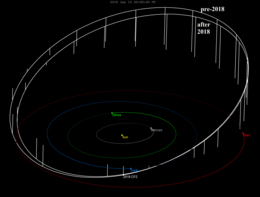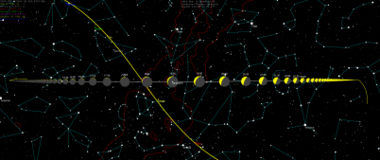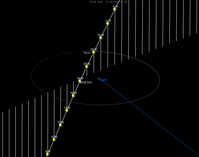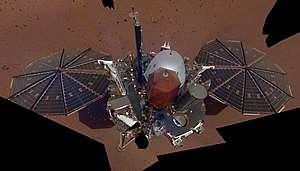2018 CF2
2018 CF2 is a micro-asteroid and near-Earth object of the Apollo group on an eccentric orbit with has an estimated 4–15 meters (10–50 ft). It was first observed on 7 February 2018, by astronomers of the Mount Lemmon Survey at Mount Lemmon Observatory, Arizona, United States.[1] The discovery occurred the day after its sub-lunar passage as it approached the Earth from a sunward direction, and this flyby altered the asteroid's orbit slightly.
 The orbit before and after its 2018-flyby | |
| Discovery [1] | |
|---|---|
| Discovered by | MLS |
| Discovery site | Mount Lemmon Obs. |
| Discovery date | 7 February 2018 |
| Designations | |
| 2018 CF2 | |
| NEO · Apollo [1][2] | |
| Orbital characteristics [2] | |
| Epoch 23 March 2018 (JD 2458200.5) | |
| Uncertainty parameter 7 | |
| Observation arc | 2 days |
| Aphelion | 2.7662 AU |
| Perihelion | 0.9089 AU |
| 1.8375 AU | |
| Eccentricity | 0.5054 |
| 2.49 yr (910 days) | |
| 29.432° | |
| 0° 23m 44.52s / day | |
| Inclination | 16.284° |
| 137.68° | |
| 320.19° | |
| Earth MOID | 0.00077 AU (0.30 LD) |
| Physical characteristics | |
Mean diameter | 4–15 m[3] 7 m (est. at 0.20)[4] 14 m (est. at 0.057)[4] |
| 28.036[2] | |
Orbit and classification
2018 CF2 belongs to the Apollo asteroids, the largest group of near-Earth objects with nearly 10 thousand known members, which cross the orbit of Earth.
Based on a high uncertainty, it orbits the Sun at a distance of 0.91–2.77 AU once every 2 years and 6 months (910 days; semi-major axis of 1.84 AU). Its orbit has an eccentricity of 0.51 and an inclination of 16° with respect to the ecliptic.[2] With an aphelion of 2.77 AU, it is also a Mars-crosser, as it crosses the orbit of the Red Planet at 1.666 AU. The body's observation arc begins at Mount Lemmon with its first observation on 7 February 2018.[1]
2018 flyby
On 6 February 2018, 18:45 UTC, the day before its first observation, it had a flyby with the Earth at a nominal distance of 0.25 lunar distances (LD).[3] Its next close approach to Earth is projected to occur on 23 January 2023, at 0.111 AU (43 LD).[2] After the 2018-passage, the body's minimum orbital intersection distance with Earth increased to 0.30 LD (0.00077 AU).[2]


Physical characteristics
The Minor Planet Center estimates a diameter of 4–15 meters (10–50 ft).[3] Based on a generic magnitude-to-diameter conversion using an absolute magnitude of 28.036,[2] the body measures between 7 and 14 meters in diameter for an assumed albedo of 0.057 and 0.20, which represent typical values for carbonaceous and stony asteroids, respectively.[4]
As of 2018, no rotational lightcurve of 2018 CF2 has been obtained from photometric observations. The body's rotation period, pole and shape remain unknown.[2]
Numbering and naming
This minor planet has not yet been numbered.[1]
References
- "2018 CF2". Minor Planet Center. Retrieved 22 February 2018.
- "JPL Small-Body Database Browser: (2018 CF2)" (2018-02-09 last obs.). Jet Propulsion Laboratory. Retrieved 22 February 2018.
- Minor Planet Center. "2018 CF2". Twitter. Retrieved 22 February 2018.
- "Asteroid Size Estimator". CNEOS NASA/JPL. Retrieved 22 February 2018.
External links
| Wikimedia Commons has media related to 2018 CF2. |
- MPEC 2018-C69 : 2018 CF2, Minor Planet Electronic Circular, 10 February 2018
- Asteroid 2018 CF2 flew past Earth at 0.25 LD, one day before discovery, The Watchers, 11 February 2018
- 2018 CF2 at NeoDyS-2, Near Earth Objects—Dynamic Site
- Ephemeris · Obs prediction · Orbital info · MOID · Proper elements · Obs info · Close · Physical info · NEOCC
- 2018 CF2 at the JPL Small-Body Database

